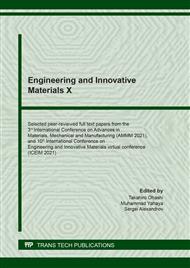[1]
Botelho, E.C., et al., A review on the development and properties of continuous fiber/epoxy/ aluminum hybrid composites for aircraft structures [J]. Materials Research, 2006, 9(3):247-256.
DOI: 10.1590/s1516-14392006000300002
Google Scholar
[2]
Sinmazçelik, et al., A review: fibre metal laminates, background, bonding types and applied test methods [J]. Materials and Design, 2011, 32: 3671-3685.
DOI: 10.1016/j.matdes.2011.03.011
Google Scholar
[3]
Vogelesang, L.B. and Vlot, A. Development of fibre metal laminates for advanced aerospace structures [J]. Journal of Materials Processing Technology, 2000, 103(1): 1-5.
DOI: 10.1016/s0924-0136(00)00411-8
Google Scholar
[4]
Alderliesten R. C., Hagenbeek M., Homan J. J., Hooijmeijer P. A., de Vries T. J., Vermeeren C.A.J.R. Fatigue and Damage Tolerance of Glare [J]. Applied Composite Materials, (2003).
DOI: 10.1023/a:1025537818644
Google Scholar
[5]
Gao, C., et al., Development of self-reinforced polymer composites [J]. Progress in Polymer Science, 2012, 37(6): 767-780.
DOI: 10.1016/j.progpolymsci.2011.09.005
Google Scholar
[6]
Zampaloni, M., et al., Kenaf natural fiber reinforced polypropylene composites: A discussion on manufacturing problems and solutions [J]. Composites Part A: Applied Science and Manufacturing, 2007, 38(6): 1569-1580.
DOI: 10.1016/j.compositesa.2007.01.001
Google Scholar
[7]
Hamza Blala, et al., (2020) Study on process control improvement hemispherical cups of GLARE Material. ACMME, 2020. https://doi.org/10.1051/matecconf/20203190400.
Google Scholar
[8]
Saeed Bagherzadeh, et al., Deformation behavior and microsturatural evolution of bimetallic sheets during metal forming processes. September 2012,Journal of Materials Processing Technology 212(9):1840-1849,.
Google Scholar
[9]
Zafar, R., Lang, L., and Zhang, R. Experimental and numerical evaluation of multilayer sheet forming process parameters for light weight structures using innovative methodology [J]. International Journal of Material Forming, 2016, 9(1): 35-47.
DOI: 10.1007/s12289-014-1198-3
Google Scholar
[10]
Hamza Blala, et al., (2020) Experimental and numerical investigation of fber metal laminate forming behavior using VBHF. https://doi.org/10.1007/s11740-020-00974-9.
Google Scholar
[11]
Shichen L, et al., Investigation into the Fiber Orientation Effect on the Formability of GLARE Materials in the Stamp Forming Process. (2017).
Google Scholar
[12]
Investigation into thinning and spring back of multilayer metal forming using HMDD for lightweight parts [J]. International Journal of Advanced Manufacturing Technology, (2016).
DOI: 10.1007/s00170-015-7415-5
Google Scholar
[13]
Lang, L., Danckert, J., Nielsen, K.B.: Investigation into hydrodynamic deep drawing assisted by radial pressure Part I. experimental observations of the forming process of aluminum alloy. https://doi.org/10.1016/j.jmatprotec.2004.01.053.
Google Scholar
[14]
Hamza Blala, et al., (2019) Investigation on the effect of blank holder gap in the hydroforming of cylindrical cups. doi.org/10.1007/s00170-020-05467-8[IJAMT].
Google Scholar
[15]
Taguchi G, Konishi S. Taguchi methods, orthogonal arrays, and linear graphs, tools for quality engineering, Dearborn, MI: American Supplier Institute, 1987, pp.35-38.
Google Scholar


